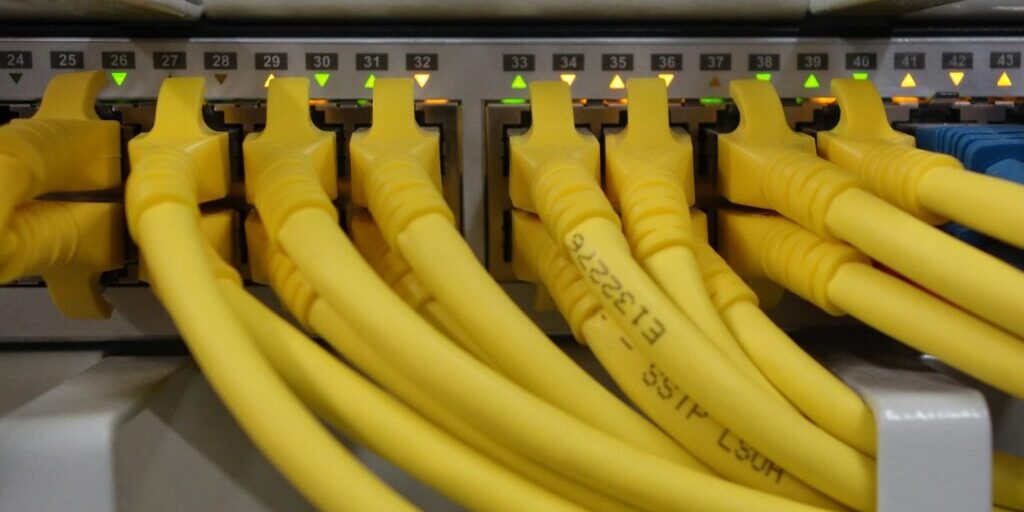There is now one confirmed entity in Nome with access to Quintillion’s fiber optic network, about two months (Dec 1st) after the service was first turned on. Other institutions are on their way to tapping into Quintillion, but consumers are still playing the waiting game.
KNOM’s Davis Hovey has the latest:
Quintillion’s Vice President of External Relations, Kristina Woolston, confirms that telecommunications providers, contracting in Nome, have bought capacity on the high-speed fiber network.
“Currently, the system has DRS on the system as well as ACS in the Nome area and then specifically moving up the coast: OTZ in Kotzebue, and Astac out of the North Slope communities of Point Hope, Wainwright, and Utqiagivk… We continue to have conversations with TelAlaska and with other providers, and have made capacity opportunities available to them, and it’s our understanding that they continue to look at the opportunity.”
According to TelAlaska’s Marketing Manager, Celine Kaplan, there are currently no developments regarding an agreement between TelAlaska and Quintillion. Negotiations are ongoing, but nothing is finalized.
Something more concrete happening in Nome is that Kawerak, as of January 15, is now using Quintillion’s fiber optic network through a provider called Alaska Communications System (ACS). Heather Cavanaugh, Director of Corporate Communications with ACS, explains that the company purchased capacity from Quintillion in order to connect businesses to the fiber system.
“It’s also worth sharing that, right now, our first phase of our part of the project is to focus on those larger institutions like schools and health care clinics and Native Corporations. We are not currently providing broadband to individual residents, and we are always looking at ways to expand our network. So, we will share more in the future when we have more information to share.”
According to Cavanaugh, ACS is working with multiple entities in Nome and elsewhere in Western Alaska to provide them high-speed broadband. Cavanaugh would not list which specific institutions ACS is contracting with, other than Kawerak, for privacy reasons.
Some Nome institutions, like the public school system, have decided to seek out telecommunications providers other than ACS. Nome Public Schools’ IT Director, Jacob Phillips, says in early March, NPS will be transitioning from GCI to DRS Technologies, a Leonardo company. According to Phillips, switching to DRS will save significant amounts of money. Currently, it costs NPS $203,000 a month for 40Mbps (Megabits per second) broadband, while DRS will only cost $48,000 a month for the same bandwidth.
Phillips explains that the school district will not recoup the majority of those savings, as more than 90% of their internet costs are covered by (USAC’s) Universal Service Administrative Company’s E-Rate program and federal grants. But overall, Phillips believes getting access to Quintillion’s fiber connection through DRS will be an improvement.
The City of Nome is also seeking a way into Quintillion’s network, but through a different provider. City Manager Tom Moran says the City and all its departments have signed a one-year extension to their contract with AT&T.
“We were still paying AT&T for the same services without entering a new contract because we wanted to see what would happen with the Quintillion project and how many retailers were available. Until we knew if there would be other vendors in the marketplace, we decided that we were going to stay with AT&T under the existing services agreement for an additional year, which I believe expires on December 31st of 2018.”
Moran says Nome Joint Utility System and the City share data capacity and split internet costs and have been doing so for a few years.
According to Utilities Manager John Handeland, within a month, AT&T will change NJUS’s service plan. Handeland expects that this will include having access to Quintillion’s network, but either way, he says the new AT&T plan will have more capacity and be faster than their current setup.
Quintillion’s Woolston says she could not comment on whether or not AT&T is negotiating with the company to purchase capacity on their fiber network. Moran says the holdup with AT&T buying capacity from Quintillion was explained to him through a non-technological analogy.
“Our understanding is that Quintillion is trying to sell hundreds of pencils, if you think of fiber in that way, they are trying to sell hundreds of pencils to people who only need one or two pencils. So even though it is so cheap per pencil, the cost is prohibitive. So that is what AT&T has explained to us, (as to) why they haven’t entered into an agreement.”
Even if the City was to tap into Quintillion’s fiber network, it is unlikely they would share that capacity with consumers in town. Moran says it’s not feasible for the City and its staff to become internet providers at this time.
“The City has never considered being the internet provider for residential accounts. The City has considered being its own internet provider, for our City and NJUS facilities. But that discussion, even though of much smaller scale, has never gotten very far. I think we have the capability to do it, but obviously it would take additional staff and it would be a pretty large undertaking, even though it was possible.”
Naturally, then, consumers turn towards one of the few telecommunications companies around, GCI. However, it doesn’t seem like GCI is interested in purchasing capacity on the Nome portion of Quintillion’s fiber, due to the $300 million GCI just spent on their TERRA – or Terrestrial for Every Rural Region in Alaska – network, which serves 84 rural communities across the state.
According to a statement from the company, GCI upgraded its internet services in communities like St. Michael, Elim, and Koyuk this month (January). GCI says these recent upgrades have almost quadrupled internet speeds for customers in Savoonga and Gambell.
Many of these upgrades are supported by the TERRA network, and as GCI’s Director of Corporate Communications, Heather Handyside, says, “Alaska’s tough terrain, vast distances, and heavily regulated land require our team to be creative when we upgrade our networks. That’s why we are using a combination of fiber, microwave, and satellites to deliver these improved services to our customers.”
Again, Handyside confirms that GCI is not using Quintillion’s fiber network to provide capacity to Western Alaskans at this time, but Quintillion’s Woolston says conversations between the two companies continue. In the coming months, GCI says they plan to roll out their own wireless service and internet upgrades in other rural communities, like Shishmaref, Teller, and Brevig Mission.
As consumers in Nome still can’t tap into the high-speed unlimited bandwidth network, which is sitting just next door, residents in the neighboring community of Kotzebue have already been using Quintillion’s fiber for more than a month. An employee with OTZ says the company has been on Quintillion’s fiber since Dec 15th and have a multi-year contract to do so.
Woolston elaborates on Quintillion’s efforts to establish contracts with telecommunications providers in the Nome area.
“We’ve been very aggressive at creating packages that address both a small capacity need for purchase and a large capacity need for purchase, and everything in-between. So we’ve been very flexible in working with potential customers in the market to provide packages that meet their needs and that meets their customers’ needs… It is our understanding that there continue to be multiple providers who are looking at residential and retail services in the Nome area.”
Woolston mentioned that she and Quintillion cannot speak on behalf of these unnamed providers, but she is hopeful they will announce new information in the near future.
For those in Nome eager for Quintillion’s high-speed, unlimited-bandwidth internet, it’s unclear how long the wait will be.







